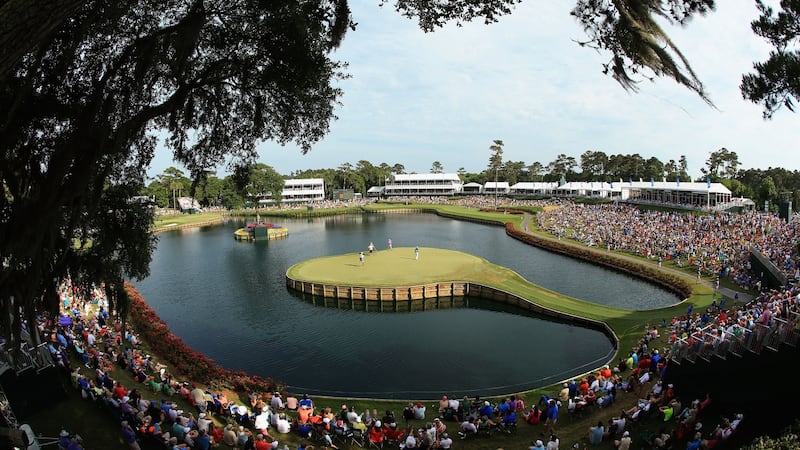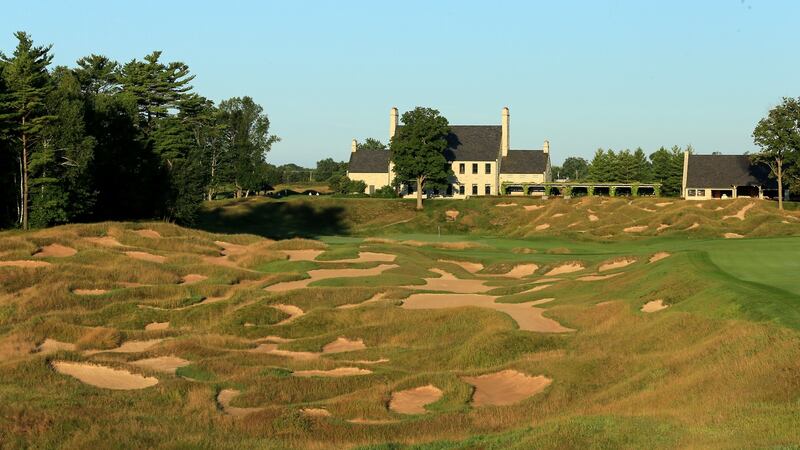Pete Dye, who designed many of America's most famous golf courses and became known as the mad scientist of golf architecture for his imaginative and supremely challenging layouts, died Thursday. He was 94.
His death was announced by the Dye family's company, Dye Designs, on Twitter. He had been treated for dementia and lived in Gulf Stream, Florida.
Often collaborating with his wife, Alice, who died in February at 91, and in later years with their two sons, Perry and Paul Burke (known as PB) Dye, Pete Dye designed more than 100 courses.
He and his wife were best known for the "island green," the 17th hole at TPC Sawgrass in Ponte Vedra Beach, Florida, probably the most photographed hole in golf history. The green is only some 135 yards from the tee, but it brings dread to even the world's greatest golfers competing in the Players Championship. Surrounded by water and connected to the rest of the course by a slender land bridge, it has tormented even the world's greatest golfers and is one of the most recognised images in the sport.

When Pete was unsure how to fill in sandy terrain he had hollowed out around the green for transfer to other spots on the course, Alice had a solution. “Originally, the water was just supposed to come into play on the right side, but we just kept digging,” the Golf Channel quoted Pete Dye as saying. “And then one day Alice came out and said, ‘Why don’t you just go ahead and make it an island?’ So we did.”
Dye named the 18th hole at his Whistling Straits course in Wisconsin Dyeabolical. A par 4 that measures at least 500 yards, it plays into often sudden and shifting winds blowing in from Lake Michigan and requires golfers to drive over sand dunes and bunkers, among some 1,000 hazards on the course.
The hole figured in a controversy certain to be long remembered when Dustin Johnson, playing in the 2010 PGA Championship, was penalised two strokes for grounding his club before hitting from what he thought was trampled-down dirt but which was determined to be an ill-defined bunker, or hazard, where grounding is not permitted. The penalty cost him a chance to enter a playoff for the title (won by Martin Kaymer of Germany).
Rarely using a set of grading plans for construction, relying instead on his instincts as he laid out a course, walking it in khakis and work boots or sitting atop a tractor, Dye emphasised strategy over raw power. “I think of Pete like Picasso, somebody that has created a nontraditional design, whether it’s a painting, a sculpture or a golf course,” prominent course designer Arthur Hills was quoted by ESPN as saying. “He was so innovative in a profession that is very traditional.”
Tiger Woods told Golf Digest in 2008: "The way Pete gets on a property and feels it is pretty impressive. His courses built for tournaments are hard, but there's a good reason for everything."
Avid golfer
Paul Dye jnr, known as PD and then Pete as a youngster, was born on December 29th, 1925, in Urbana, Ohio, one of three children of Paul Francis and Elizabeth (Johnson) Dye. His father, an insurance agent, was also an avid golfer and helped build a country-club course.
Pete began playing golf as a boy in Florida, where his parents spent the winter months because of his asthma, and he went on to win the Ohio state high school golf championship. While serving in the US army during the second World War, Dye tended the golf course at Fort Benning, Georgia. Later, when he was stationed at Fort Bragg, North Carolina, officers who learned of his golf background began making daily trips with him to play the Pinehurst No. 2 course.
He met Alice O’Neal when they were on the varsity golf teams at Rollins College in Winter Park, Florida. Alice graduated in 1948, but Pete dropped out. They were married in 1950, settled in Indianapolis and sold insurance there. Dye played in the US Open in 1957, but his future lay in creating courses, and in 1959 Pete and Alice designed their first course, the nine-hole El Dorado Golf Club in Indianapolis. Being untrained in golf architecture, however, they struggled for assignments.
“We were the proverbial babes in the woods in a profession that was mostly non-existent at the time,” Pete Dye recalled in his 1995 memoir, “Bury Me in a Pot Bunker,” written with Mark Shaw. “Alice and I would design a course based on the thoughts, images and memories of the many great courses we had played across the United States.”

The turning point in their career came in 1963, after Dye competed in the British amateur championship on the Old Course at St Andrews in Scotland. Pete and Alice toured more than 30 courses in Scotland and England, and they photographed them as they played.
As Pete Dye recalled in his memoir: “My new understanding of the use of small greens, wide fairways, the impression that ground-level greens were elevated, contrasting grass mixes, severe undulations in the fairways, pot bunkers, railroad ties, blind holes and the inclusion of gorse-like vegetation to frame holes would affect all our future designs.”
In the mid-1960s, the Dyes carved a course from a 400-acre cornfield outside Indianapolis. While walking the grounds during construction, Dye had picked up a knobby, crooked stick and used it to swat at a stone. As the story went, one of the club’s charter members suggested that he call the course Crooked Stick; it became the Dyes’ first renowned design.
Dye wanted the pressure to build on golfers as they neared the final three holes at Crooked Stick, so he created water hazards or bunkers to guard them. The greens, meanwhile, were at ground level but appeared elevated because large chunks of earth had been removed in front of them. Crooked Stick Golf Club in Carmel, Indiana, stamped itself on the golf world in 1991 when the unheralded John Daly won the PGA Championship there, overwhelming the course with prodigious drives.
Dye collaborated with Jack Nicklaus in designing the Harbour Town Golf Links on Hilton Head Island, South Carolina. Opening in 1969 as the site of the Heritage Classic and known for its red and white lighthouse overlooking the 18th hole, it required golfers to hit to specific areas in order to master it at a time when many courses demanded powerful drives.
TPC Sawgrass
Dye was probably best remembered for TPC Sawgrass, built on Florida swampland. At the suggestion of Deane Beman, the PGA commissioner at the time, it became the first prominent stadium course, allowing spectators to view the action from elevated areas of the terrain. Since the course opened in 1980, the fans have been amused by all those balls landing in the water at the 17th hole, so near but so frustrating for golf’s elite at the Players Championship.
"What's amazing is that if that green were surrounded by sand instead of water, those guys would never miss the green," golf coach Butch Harmon once remarked.
The Dye roster of courses also includes PGA West, near Palm Springs, California, and the Ocean Course, on Kiawah Island in South Carolina. Pete Dye received the PGA Tour Lifetime Achievement Award in 2005 and was inducted into the World Golf Hall of Fame in 2008. Alice Dye was given the PGA of America's First Lady of Golf Award in 2004. In addition to her course design work, she championed forward tees that make formidable courses more playable for most women as well as for male players outside the pro ranks.
In addition to his two sons, Dye had two grandchildren and two great-grandchildren. Complete information on his survivors was not immediately available.
Dye continued to design courses into his 80s. Golf Digest named his course at French Lick, Indiana, the best new public course in the United States in 2009, and Golf Magazine gave the course its top honour, best new course of the year. He created his first course in New York state in 2008, the public but championship-calibre Pound Ridge Golf Club in Westchester County. Pound Ridge’s 15th hole, a short par 3, reflected Dye’s sense of adventure. He left in place a large craggy rock on a hill overlooking the green. If a golfer overshot the green, the rock deflected some balls onto the putting surface. But it could also send a shot rebounding into a water hazard.
“Some golfers will hit that rock, and when their ball ricochets onto the green, they’ll say this is a great golf hole,” Dye told The New York Times. “And some golfers, when they will hit that rock, their ball will disappear, and they’ll say this is the worst hole they’ve ever seen.” – New York Times
















